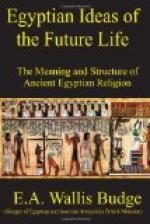of the first Egyptian king, who died in his early youth;
see Herodotus, ii. 79.] whom the Egyptians so frequently
call upon in their banquets, is none other than
this very boy. This relation is again contradicted
by such as tell us that the true name of the child
was Palaestinus, or Pelusius, and that the city of
this name was built by the Goddess in memory of
him; adding farther, that the Maneros above mentioned
is thus honoured by the Egyptians at their feasts,
because he was the first who invented music.
There are others, again, who affirm that Maneros
is not the name of any particular person, but a
mere customary form, and complimental manner of greeting
made use of by the Egyptians one towards another
at their more solemn feasts and banquets, meaning
no more by it, than to wish, that what they were then
about might prove fortunate and happy to them, for
that this is the true import of the word. In
like manner, say they, the human skeleton, which
at these times of jollity is carried about in a box,
and shewn to all the guests, is not designed, as
some imagine, to represent the particular misfortunes
of Osiris, but rather to remind them of their mortality,
and thereby to excite them freely to make use of
and to enjoy the good things which are set before them,
seeing they must quickly become such as they there
saw; and that this is the true reason of introducing
it at their banquets—but to proceed in the
narration.
“Isis intending a visit to her son Orus, who was brought up at Butus, deposited the chest in the meanwhile in a remote and unfrequented place: Typho however, as he was one night hunting by the light of the moon, accidentally met with it; and knowing the body which was enclosed in it, tore it into several pieces, fourteen, in all, dispersing them up and down, in different parts of the country—Upon being made acquainted with this event, Isis once more sets out in search of the scattered fragments of her husband’s body, making use of a boat made of the reed Papyrus in order the more easily to pass thro’ the lower and fenny parts of the country—For which, reason, say they, the crocodile never touches any persons, who sail in this sort of vessels, as either fearing the anger of the goddess, or else respecting it on account of its having once carried her. To this occasion therefore is it to be imputed, that there are so many different sepulchres of Osiris shewn, in Egypt; for we are told, that wherever Isis met with any of the scattered limbs of her husband, she there buried it. There are others however who contradict this relation, and tell us, that this variety of Sepulchres was owing rather to the policy of the queen, who, instead of the real body, as was pretended, presented these several cities with the image only of her husband: and that she did this, not only to render the honours, which would by this means be paid to his memory, more extensive, but likewise that she might hereby elude the malicious search of Typho;




